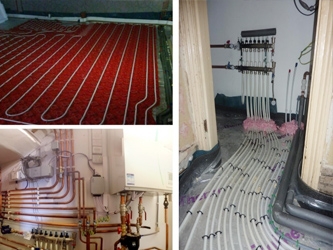Underfloor Heating
Underfloor heating can’t be talked about without mentioning its main competition, radiators. For years the UK has used radiators which are wall mounted, to heat our homes, traditionally linked to a gas or oil boiler or even solid fuel unit. Our European counterparts have been seeing the benefits of underfloor for decades whether this be electric or a wet system. The choices below are related to a wet system.
Radiators are actually very efficient at what they do, the main pros and cons are listed below.
The Advantages of Radiators
1. Quick reaction time.
2. Can be changed to increase or decrease output or if faulty.
3. Generally cheaper to install.
The Disadvantages of Radiators
1. Dust collectors.
2. Can be bulky in size and take up vital space.
3. Can corrode and require replacing.
4. Balance of heat can be at top of room, rather than nearer your feet.
5. Radiator and pipework can be damaged.
6. Awkward to decorate behind.

Why Underfloor Heating is More Efficient
An example of an average room:
It might be 2.5m x 5m in size and will typically have a radiator which is about 1.5m long x 600mm high. The total surface area of the radiator is therefore 1.5 x 0.6 = 0.9m2
The floor of this room has an area of 2.5 x 5 = 12.5m2 so the floor area is about 14 times bigger than the radiator. If we could buy a radiator the size of the surface area of the floor, we would have a very hot room, but this gives you the benefit of being able to reduce to flow temperatures, which in turn would require less energy, and certain modern day condensing boilers thrive on low temperatures. Heat pumps run at their best when the temp is low, and most certainly all the materials connected to the heating system are put under less stress not have to deal which such huge temperatures fluctuations, so tends to prolong the life of the system. All of this leads to low running costs.
The Advantages of Underfloor Heating
1. Large surface area giving more option for
outputs/inputs.
2. No convection of heat and hence no drafts or cold spots in the room.
3. Rooms ‘feel’ warmer and hence room temperatures can be reduce by one or two degrees
4. It works with lots of different floor constructions and coverings
5. No pipes or radiators to paint or gather dust
6. Placement of furniture has little effect on heating efficiency
7. The comfort level is where people are, this is improved as the heat comes below and rises.
8. Lower temperatures into the heating system which can reduce running costs
The Disadvantages of Underfloor Heating
1. Costs to install in existing property (retro-fit) more.
2. Costs to install in new or whilst re-furbishing a property marginally more, but would see benefits quicker as result.
3. Slower reaction times on warm up and cool down.
4. Space need to be found for manifold unit which must be accessible for maintenance.

Key Points When Designing Your Underfloor Heating
1. Heat loss of room
2. Heat source (e.ge Heat Pump, Gas Boiler etc)
3. Finished floor surface.
All three points will helps decide spacing of pipework distances apart, this determines output, the closer together and the higher the flow temp, the greater the output. If room is screed floor with tiled/stone floor this will give maximum output, feels great to walk on and has a good thermal mass, this is normally classed as the best route to go down. Whereas suspended floor with underlay and carpet floor will reduce output. If the area is very small it may be better to install a electric matt system, e.g. for a small bathroom or en-suite, especially if you factor in extra install costs for suspended floor system, and if it the only room in property to be heated this way.
For all of this it needs to be calculated and designed by a reputable company.
Additional Useful Information
The type of manifold used is relevant to the output, eg you would
require a blending valve for a heat source with high temperature
output e.g. an oil boiler, whereas a low temp heat pump will not
actually work at its best on a manifold with a blending valve.
Additionally you can have weather compensation as part of the
manifold which in simple terms raises the temperature of the floor
as the exterior temperature drops, likewise it will reduce the
temperature as it get warmer thus reducing energy consumption. To
achieve this, a heating curve needs to be set up in the
compensator. Many modern heat pumps and some boiler now have
weather comp built in which can negate the manifold to have weather
comp.
If each room has its temperature/time control, allow for when the room is used, most people follow a set pattern, so when not it use you can run the room at lower temperature. If all this is part of install, we are talking about having the near perfect heating system which would practically run itself.
Main Types of Underfloor Heating
1. Screed floor.
2. Suspended floor.
3. Other options.
Their type main types of wet underfloor heating falls into two main categories, screed and suspended, however you can now have a suspended floor with screed between joists. There is a huge variation on these, e.g. screed floor with floating floor. The suspended floor options are endless.
Useful information sheets & brochures (downloadable PDF)
» UFH + gas boiler clip + screed, Northam Devon
» Underfloor heating / heat pump / clip + screed / North Molton, Devon
» UFH / gas boiler / tray & screed / South Molton/ Devon
» UFH + oil boiler / over floor / Woody bay Devon
» UFH + oil boiler / reflective plate / Westward Ho Devon
» Underfloor heating / heat pump clip direct + screed, South Molton Devon








